Abstract
A remarkable increase is recorded regarding global burden of non-communicable lifestyle diseases. Prevalence of non-infectious diseases especially type 2 Diabetes, hypertension, depression, anxiety, arthritis etc. are directly related with the lifestyle patterns including the “Diet” that has been consumed during the course of lifetime. Food and health are correlated; improper food intake will produce detrimental effects on health leading to altered body physiology ultimately resulted in persistent illness. By incorporating functional foods in daily routine will strengthen the overall health and immune system, detoxify the organs, leading to delay age related degeneration of organs and symptoms. Purpose of this study was to design a unique functional food termed as “Rainbow Paratha” using whole wheat flour (Triticum aestivum) as main medium mixed with antioxidants herbs mainly Beeta vulgaris leaves and root and Moringa oleifera leaves. To add on taste and nutritional value some wet condiments (ginger, garlic, turmeric, and onion) and some dry condiments (black pepper, cumin, and fenugreek) were also added. Taste was developed using pink salt and mustard oil, while garnishing was done with coriander and peppermint leaves to make paratha presentable. Dough was made using mustard oil and distilled water. This paratha is safe to use as a functional food, boost immunity and improve health. Natural antioxidants in this paratha will detoxify the body with reactive oxygen species preventing from chronic diseases. It can be concluded that this product will not only satisfy the hunger and provide prompt responding nutrients to consumers but may prevent some lifestyle diseases and try to maintain perfect health without any untoward effects.
Keywords
Beeta vulgaris roots and leaves, Moringa oleifera, Functional food, Immunity, Chronic diseases
Introduction
Food provides the basic fuel necessary for the survival and maintenance of human life. On scientific ground relationship between diet and health has been established and studied by researchers all over the world. Unbalanced diet or processing of food in unscientific manner will result in compromised nutritional value; finally leading to the prevalence of different diseases. Japan introduced the term functional food for the first time in mid 80s, by then it has been adopted the shape of modern industry all over the world. The Concept of functional food is nothing but based on two main parameters of human life i.e. diet and health. Any food that may be utilized on daily basis for preventing diseases via improving overall health is considered as functional food. Functional foods may be conventional natural food, having fortified food components, and synthesized food ingredients. There are a lot of data available that support the practice of incorporating functional food on daily routine will result in improved health and delay of chronic diseases like hypertension, diabetes etc. [1-4].
Majority of chronic diseases are associated with high oxidative stress on the body. Increased level of Reactive Oxygen Species (ROS) or free radicals in the body will gradually result in prevalence of lifestyle diseases like hypertension, diabetes, neurodegenerative diseases like Alzheimer’s, and even malignant conditions of various organs [5-9].
Nature has blessed humankind with a range of edible and medicinal plants having antioxidant potential and these are available according to seasonal variations. Incorporation of edible plants having natural antioxidants in our daily diet plan can improve our health through maintaining body’s own metabolic processes ; strengthen immune system, boosting body’s own free radical scavenging activity. Hence the overall health condition will be improved and the natural process of aging and age related complications could be minimized.
Purpose of this research is to introduce a natural functional food after pandemic situation of COVID-19 that has antioxidant and immune boosting potential, known as “Rainbow Paratha”. We made this paratha using whole wheat flour, mixing with edible Beeta vulgaris roots and leaves and Moringa oleifera that are rich in antioxidant poly phenols and can be safely consumed as are non-toxic [10,11,16,17]. Other condiments having beneficial and safe phytochemicals are also added to add on flavor according to the taste buds of Asians population. Grated rhizome of ginger and garlic along with onion were used as wet condiments of the preparation. Dry condiments are also the primary part of the preparation like turmeric, cumin, black pepper, and fenugreek along with maintaining the taste with pink salt, with coriander and peppermint leaves not only as garnishing agent but also for significant taste and aroma. Mustard oil was used to process the dough into cooked paratha that itself have very advantageous effects. All of these wet and dry condiments are routinely utilized in Pakistani cuisines and not only enhance the taste but also beneficial for health as containing valuable phytochemical nutrients that can be used in moderate amounts.
Materials and Methods
Preparation of rainbow paratha is composed of some simple steps including collection of ingredients, dough preparation, processing the dough, and cooking.
Collection of Material/Ingredients
Ingredients used in the preparation of rainbow paratha were procured from local market of Karachi, Pakistan and identified by Prof. Dr. Ghazala H Rizwani. It includes some fresh materials as well as some regional spices (wet and dry condiments) according to the taste of local Pakistani population. All the materials required for making rainbow paratha are listed in Table 1.
Table 1: Description of Composition of Rainbow paratha
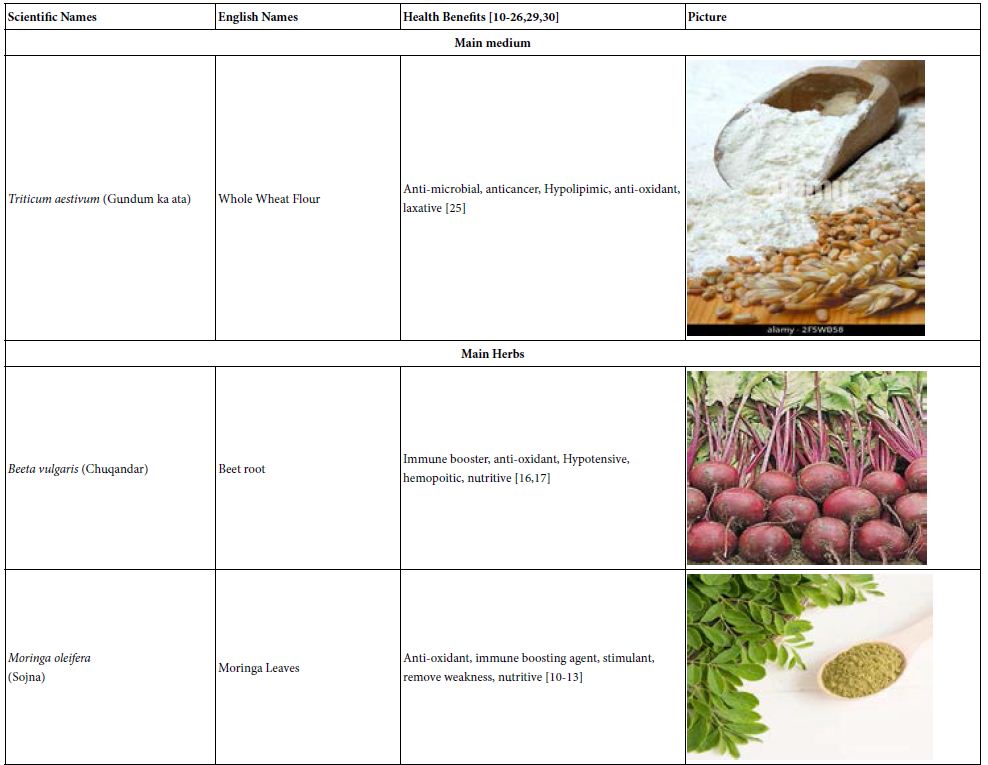
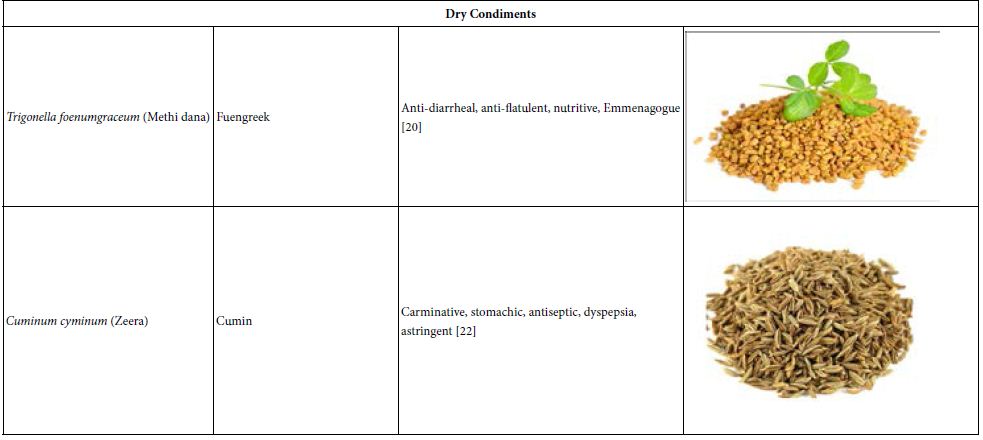
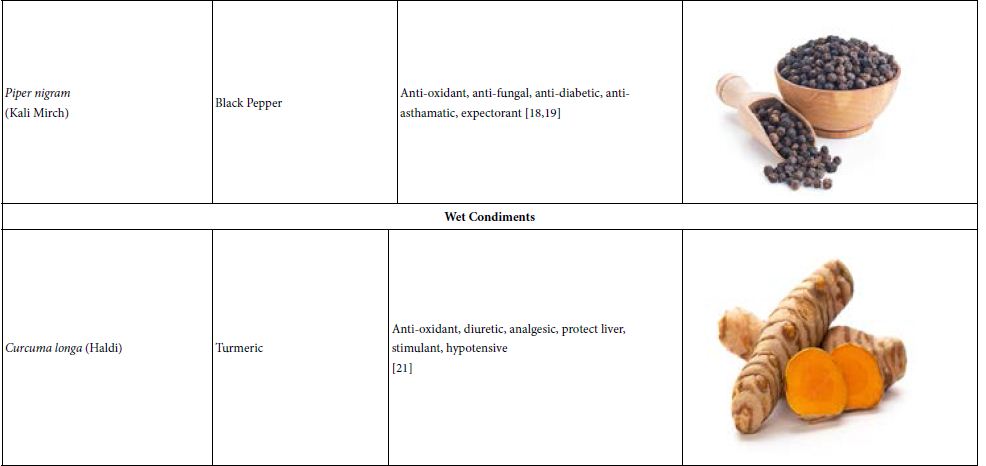
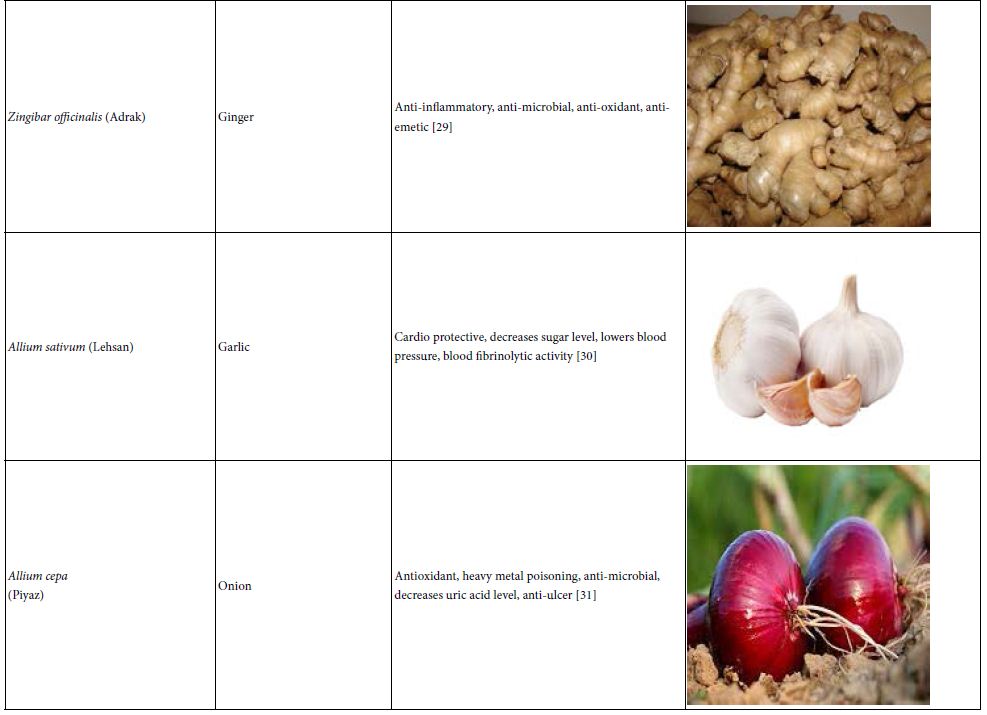
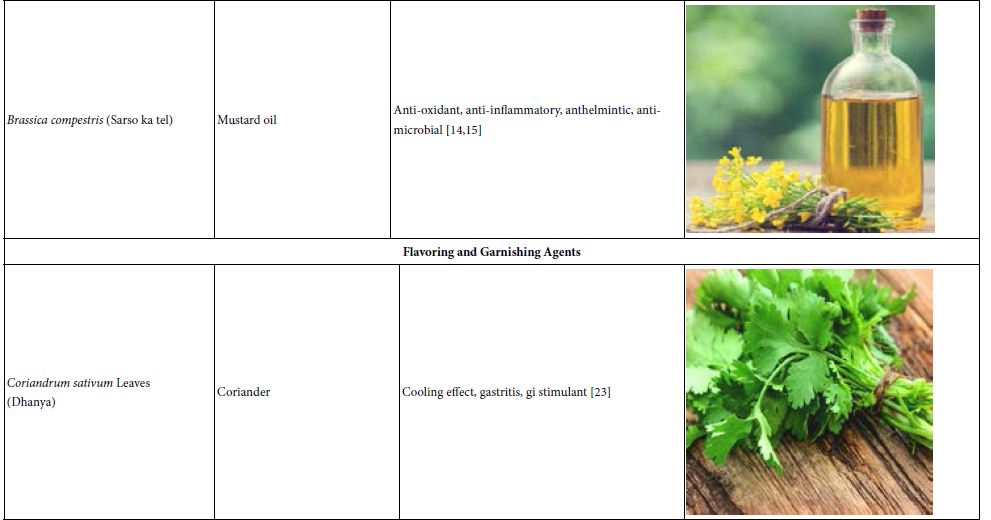
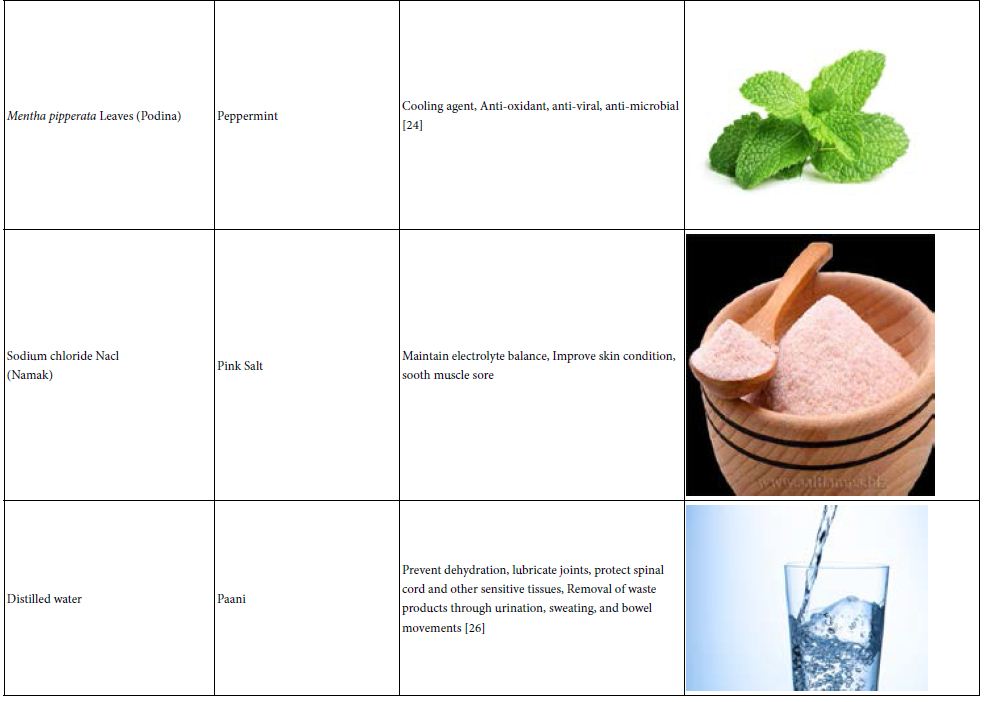
Experimental Design
Dough Preparation and Processing
Table 2 represents the percentage amount of all ingredients used to make the dough; while all steps involved in the preparation of this product is summarized in Figure 1. Firstly all dry ingredients were mixed well in flour followed by gradual addition of cooking oil. Simple drinking water was used for Dough preparation. Dough was kneaded with the help of hands to obtain uniform consistency. It was covered with moist muslin cloth at room temperature for half an hour before further processing. The respective dough was divided into small pieces of approximately equal size. Each piece of dough was rolled out in the shape of round Paratha using roller pin.
Table 2: Percentage composition of Ingredients used in rainbow paratha
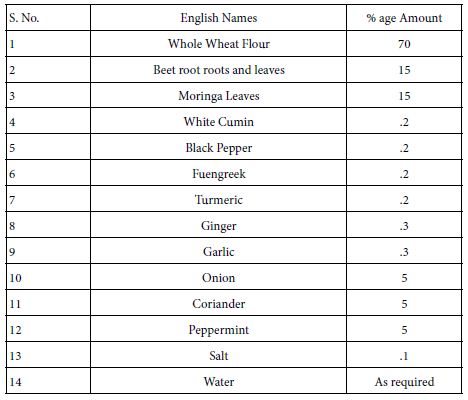
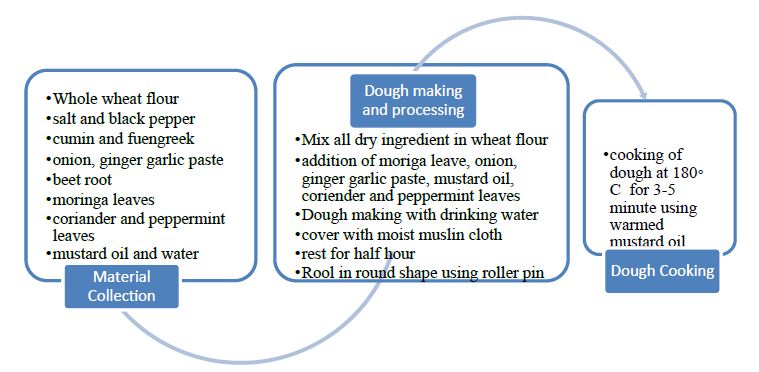
Figure 1: Steps involved in making Rainbow Paratha
Cooking of Paratha dough
The resulted prepared dough in addition with 2-3 table spoons of mustard oil warmed at 180 C for at least 5 minutes on a nonstick pan. Warming of mustard oil till smoke point is necessary to remove its toxic constituents allyl isothiocyanate responsible for its bitter taste and to convert bitter oil into edible sweet mustard oil.
Results and Discussion
COVID-19 pandemic has influenced the life of mankind in various aspects including from physical and mental health, economy, socialization and the overall immune system. Post pandemic scenario has opened new global challenges for medical professionals, pharmacists, dieticians, and researchers to address and solve health complications and strengthen the immune system so that our bodies will be able to defend itself in case of reoccurrence of the disease or other variant of corona virus. A strong immune system will safeguard the person with all kinds of illness and complications.
In 21st century attention is paid towards maintain the diet in such a way that food itself becomes medicine for individuals. Concepts of functional foods, neutraceutical reflecting the healthy eating habits are on the rise to boost up immunity. The concept of our research of designing rainbow paratha is based on this fact that by incorporating healthy food items having antioxidant potential in our cuisine will help naturally us to fight against diseases.
Rainbow paratha is prepared using wheat flour as main medium, with antioxidants herbs, and some dry and wet condiments and flavoring agents. The details of all components of rainbow paratha are given as;
Main Medium
Triticum aestivum (Whole Wheat Flour)
Whole wheat flour was taken as main medium to prepare the dough. It was selected because wheat flour is the most widely used type of grain in Pakistan. Although due to high amount of carbohydrate it is considered as a source of energy but it also perform some valuable functions like anti-diabetic, anti-microbial, and even anti-malignant effects also [25].
Main Herbs
Beta vulgaris (Beet Root and leaves)
Beet root is highly nutritive food full of vitamins, mineral, and nitrates. Fresh beet roots with its green leaves are used in this product that has miraculous effects on health. Most of the chronic diseases are slowly developing in the body, moreover gradual accumulation of toxins and metabolic wastes will weaken the immune system and damages organs. Use of beet root with its leaves detoxifies liver getting rid from disease progression. It is also beneficial to main high blood pressure so delays the onset of hypertension in border line patients. It is also helpful in making heart health in good condition; also decreases cholesterol levels. Due to hemopoitic action it is good for treating anemia [16,17].
Moringa oleifera (Moringa leaves)
Moringa oleifera is known as “Magical vegetable” because of its miraculous uses both as functional food and medicine. Its use has not only been proved scientifically effective but also safe for human consumption. In our Rainbow paratha recipe we used fresh leaves of moringa that are rich in natural antioxidants like vitamin C, poly phenols, and carotenoid. Moringa plant has long history of therapeutic utilization in traditional system of medicines for its anti-inflammatory, anti-microbial, diuretic, anti-hyperlipidemic, anti-hypertensive, anti-diabetic activities. Presence of these antioxidants will decrease the oxidative stress hence preventing from different chronic diseases [10-13].
Dry Condiments
Piper nigrum (Black pepper)
Black pepper having a characteristic spicy and pungent odor and taste is very popular food condiment in Asian cuisines. This plant has deep cited history of use as medicine as well as food spice. Piperine, piperidine are the main constituents responsible for medicinal actions. It is widely used for respiratory complaints [18,19].
Trigonella fonumgraceum (Fenugreek)
Fenugreek is another condiment used in making rainbow paratha. It is also one of the popular food condiments in Asia having nice aroma and bitter taste. Methi dana is rich in fat soluble vitamins A and D, Steroidal sapogenin, disogenin, hecogenin, mucilage, Wax, volatile oil and used as tonic, flatulence, antidiarrheal, emonenagouge and laxative [20]. Since it has a bitter taste so whole seeds are used instead of crushing it to maintain the taste.
Cuminum cyminum (White Cumin)
Whit cumin has characteristic aromatic odor and spicy taste. It contains Essential oil especially pinene, cuminic aldhehyde (25-35%) and used as diuretic, carminative, condiment, stomachic, astringent, anti-diarrheal, dyspepsia, antiseptic, flavoring agent [22].
Wet Condiments
Curcuma longa (Turmeric)
Curcuminoids (Curcumin, Demethoxycurcumin, Bisdemethoxycurcumin) are Nontoxic Polyphenolic derivatives of Curcumin that make it very beneficial. It is used as analgesic, diuretic, antioxidant, bactericidal, hypotensive, rubefacient, stimulant, reduce risk of serious health conditions like heart disease, diabetes, sores, bruises, osteoarthritis [21].
Allium sativum (Garlic)
Garlic is well known for its cardio protective action, it protects the heart, lowers blood pressure, shows fibrinolytic activities [30].
Allium cepa (Onion)
Onion is a widely used ingredient of Pakistani cuisine. Due to its detoxification action, it prevent tissue, organ and system damage from Heavy metal and other type of poisoning. Uric acid level is also controlled by incorporating onion in daily routine [31].
Brassica compestris (Mustard oil)
Mustard oil has a strong and pungent flavor with high smoke point. Isothiocyanate, Glucosynolate also known as mustard oil glycosides is responsible for the characteristic taste and aroma of mustard oil. Mustard oil is very beneficial for health due to its unique fatty acid composition. It reduces cholesterol level, well for heart, anti-inflammatory, treat pain associated with arthritis; stimulate sweat gland and lower body temperature [14,15]. Heating the oil will mask its pungent taste so in our recipe mustard oil was heated till its smoke point prior to use it.
Garnishing and Flavoring Agents
Coriandrum sativum (Coriander)
Fresh coriander leaves were used. It contains Camphor, geraniol, Coriandrol, Linalool, pinene, limonene, carvone and used for rheumatisem, dysentery, piles, flatulence, hernia Measles, nausea, and toothache [23].
Mentha pipperata (Peppermint)
Peppermint leaves contain essential oil like methol, menthone, limonine showing antioxidant, anti-microbial, anti-viral activities [24].
The paratha is a processed product of dough. All steps of dough making are physical i.e. mixing of ingredients, kneading the material with water to make dough, resting period. All these physical steps does not affect the nutritional value of paratha as a functional food; the only step that can change the nature of thermolabile phytochemicals especially polyphenol is the conversion of thin rolled sheets of dough into the processed form paratha i.e. “cooking the dough at 18°C for at least 5 minutes”.
As Rainbow paratha recipe contains multiple ingredients, but all ingredients are edible and safe to utilize in daily routine. Processing of paratha is also very easy and simple; moreover its taste is also very good. It is very tasty functional food that can easily be made at home having very low cost budget.
Conclusion
After COVID-19 pandemic health conditions of people all over the globe is facing challenges. In most of the individuals immune system has been weakened in post pandemic conditions altering both Physical and mental status of populace. It is recommended to make awareness among people to maintain their health in better condition by incorporating functional foods like rainbow paratha by just adding some condiments in the traditional simple paratha which is a must part of Pakistani traditional cuisine almost at every home. It can help in strengthen the immune system and overall improved health condition of community.
References
- Clare M Hasler (2002) Functional Foods: Benefits, Concerns and Challenges—A Position Paper from the American Council on Science and Health The Journal of Nutrition 132: 3772-3781. [crossref]
- Henry C (2010) Functional foods. Eur J Clin Nutr 64: 657-659.
- Monica Butnariu, Ioan Sarac (2019) Functional Food. International Journal of Nutrition 3: 7-16.
- Temple NJ (2022) A rational definition for functional foods: A perspective. Nutr 9. [crossref]
- Schieber M, Chandel NS (2014) ROS Function in Redox Signaling and Oxidative Stress Review Current Biology 24: R453-R462. [crossref]
- Pizzino G, Irrera N, Cucinotta M, Pallio G, Mannino F, et al. (2017) Oxidative stress: Harms and benefits for human health, Oxidative medicines and cellular longevity 2017: 13. [crossref]
- Rajendran P, N Nandakumar, T Rengarajan, R Palaniswami, EN Gnanadhas, et al. (2014) “Antioxidants and human diseases,” Clinica Chimica Acta 436: 332-347. [crossref]
- Kumar S, AK Pandey (2015) “Free radicals: health implications and their mitigation by herbals,” British Journal of Medicine and Medical Research 7: 438-457. [crossref]
- Valko M, D Leibfritz, J Moncola, MD Cronin, M Mazur, et al. (2007) “Free radicals and antioxidants in normal physiological functions and human disease,” The International Journal of Biochemistry & Cell Biology 39: 44-84. [crossref]
- Vergara-Jimenez M, Almatrafi MM, Fernandez ML (2017) Bioactive Components in Moringa Oleifera Leaves Protect against Chronic Disease. Antioxidants (Basel) 6: 91. [crossref]
- Stohs SJ, Hartman MJ (2015) Review of the Safety and Efficacy of Moringa oleifera Res 29: 796-804. [crossref]
- Vongsak B, Sithisarna P, Mangmool SB, Thongpraditchote S (2013) Maximizing total phenolics, total flavonoids contents and antioxidant activity of Moringa oleifera leaf extract by the appropriate extraction method Industrial Crops and Products 44: 566-571.
- Sreelatha S, Padma PR (2009) Antioxidant Activity and Total Phenolic Content of Moringa oleifera Leaves in Two Stages of Maturity. Plant Foods Hum Nutr 64: 303. [crossref]
- BKKK Jinadasa, F Van Bockstaele, JH Cvejic, Jesus Simal-Gandara (2022) Chapter 11 – Current trends and next generation of future edible oils, Editor(s): Rajeev Bhat, Future Foods, Academic Press 2022: 203-231.
- Chakraborty S, Gupta SS, Sengupta A, Ghosh M (2018) Quality ascertain of different mustard oil samples Obtained from the Local market of West Bengal, India. Asian Journal of Dairy and Food Research 37: 138-143.
- Neha P, Jain SK, Jain NK, Mittal HK (2018) Chemical and functional properties of Beetroot (Beta vulgaris L.) for product development: A review International Journal of Chemical Studies 6: 3190-3194.
- El Gamal AA, AlSaid MS, Raish M, et al. (2014) Beetroot (Beta vulgaris L) extract ameliorates gentamicin-induced nephrotoxicity associated oxidative stress, inflammation, and apoptosis in rodent model. Mediators Inflamm 2014: 983952. [crossref]
- Saleem A, Naureen I, Naeem M, Tasleem G, et al. (2022) Therapeutic Role of Piper Nigrum L (Black Pepper) and Pharmacological Activities. Sch Int J Biochem 5: 15-21.
- Meghwal M, Goswami TK (2013) Piper nigrum and piperine: an update. Phytother Res 27: 1121-1130. [crossref]
- Yadav UC, Baquer NZ (2014) Pharmacological effects of Trigonella foenum-graecum L. in health and disease. Pharm Biol 52: 243-254. [crossref]
- Kocaadam B, Şanlier N (2017) Curcumin, an active component of turmeric (Curcuma longa), and its effects on health. Crit Rev Food Sci Nutr 57: 2889-2895. [crossref]
- Singh RP, Gangadharappa HV, Mruthunjaya K (2017) Cuminum cyminum – A Popular Spice: An Updated Review, Pharmacognosy Journal 9: 292-301.
- Laribi B, Kouki K, M’Hamdi M, Bettaieb T (2015) Coriander (Coriandrum sativum L.) and its bioactive constituents. Fitoterapia 103: 9-26. [crossref]
- Schmidt E, Bail S, Buchbauer G, Stoilova I, Atanasova T, et al. (2009) Chemical composition, olfactory evaluation and antioxidant effects of essential oil from Mentha x piperita. Nat Prod Commun 4: 1107-1112. [crossref]
- Minocha N, Saini S, Pandey P (2022) Nutritional prospects of wheatgrass (Triticum aestivum) and its effects in treatment and chemoprevention. Explor Med 3: 432-442. [crossref]
- Centers of Disease Control and Prevention (CDC). Water and Healthier Drinks; Healthy Weight, Nutrition, and Physica Activity.
- World Health Organization (WHO). Post COVID-19 condition.
- World Health Organization (WHO). The impact of COVID-19 on mental health cannot be made light of.
- Mao QQ, Xu XY, Cao SY, et al. (2019) Bioactive Compounds and Bioactivities of Ginger (Zingiber officinale Roscoe). Foods 8: 185. [crossref]
- El-Saber Batiha G, Magdy Beshbishy A, G Wasef L, Elewa YHA, et al. (2020) Chemical Constituents and Pharmacological Activities of Garlic (Allium sativum L.): A Review. Nutrients 12: 872. [crossref]
- Dorrigiv M, Zareiyan A, Hosseinzadeh H (2021) Onion (Allium cepa) and its Main Constituents as Antidotes or Protective Agents against Natural or Chemical Toxicities: A Comprehensive Review. Iran J Pharm Res 20: 3-26. [crossref]